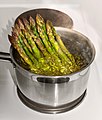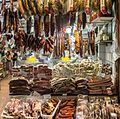Portal:Food
F o o d
A portal dedicated to food and foodways
Introduction
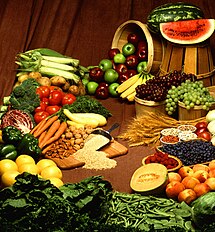
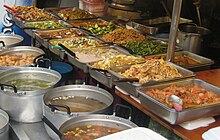
Food is any substance consumed by an organism for nutritional support. Food is usually of plant, animal, or fungal origin and contains essential nutrients such as carbohydrates, fats, proteins, vitamins, or minerals. The substance is ingested by an organism and assimilated by the organism's cells to provide energy, maintain life, or stimulate growth. Different species of animals have different feeding behaviours that satisfy the needs of their metabolisms and have evolved to fill a specific ecological niche within specific geographical contexts.
Omnivorous humans are highly adaptable and have adapted to obtain food in many different ecosystems. Humans generally use cooking to prepare food for consumption. The majority of the food energy required is supplied by the industrial food industry, which produces food through intensive agriculture and distributes it through complex food processing and food distribution systems. This system of conventional agriculture relies heavily on fossil fuels, which means that the food and agricultural systems are one of the major contributors to climate change, accounting for as much as 37% of total greenhouse gas emissions. (Full article...)
Cooking, also known as cookery or professionally as the culinary arts, is the art, science and craft of using heat to make food more palatable, digestible, nutritious, or safe. Cooking techniques and ingredients vary widely, from grilling food over an open fire, to using electric stoves, to baking in various types of ovens, reflecting local conditions. Cooking is an aspect of all human societies and a cultural universal.
Preparing food with heat or fire is an activity unique to humans. Archeological evidence of cooking fires from at least 300,000 years ago exists, but some estimate that humans started cooking up to 2 million years ago.
The expansion of agriculture, commerce, trade, and transportation between civilizations in different regions offered cooks many new ingredients. New inventions and technologies, such as the invention of pottery for holding and boiling of water, expanded cooking techniques. Some modern cooks apply advanced scientific techniques to food preparation to further enhance the flavor of the dish served. (Full article...)

The radish (Raphanus sativus) is a flowering plant in the mustard family, Brassicaceae. Its large taproot is commonly used as a root vegetable, although the entire plant is edible and its leaves are sometimes used as a leaf vegetable. Originally domesticated in Asia, radishes are now grown and consumed throughout the world. The radish is sometimes considered to form a species complex with the wild radish, and instead given the trinomial name Raphanus raphanistrum subsp. sativus.
Radishes are often used raw as a crunchy salad vegetable with a pungent, slightly spicy flavor, varying in intensity depending on its growing environment. There are numerous varieties varying in size, flavor, color, and length of time they take to mature. Radishes owe their sharp flavor to the various chemical compounds produced by the plants, including glucosinolate, myrosinase, and isothiocyanate. They are sometimes grown as companion plants and suffer from few pests and diseases. They germinate quickly and grow rapidly, common smaller varieties being ready for consumption within a month, while larger daikon varieties take several weeks. Being relatively easy to grow and quick to harvest, radishes are often planted by novice gardeners. Another use of radish is as a cover or catch crop in winter, or as a forage crop. Some radishes are grown for their seeds; others, such as daikon, may be grown for oil production. Others are used for sprouting. (Full article...)
Selected article –
The history of pizza began in antiquity, as various ancient cultures produced flatbreads with several toppings. Pizza today is an Italian dish with a flat dough-based base and toppings, with significant Italian roots in History.
A precursor of pizza was probably the focaccia, a flatbread known to the Romans as panis focacius, to which toppings were then added. Modern pizza evolved from similar flatbread dishes in Naples, Italy, between the 16th and mid-18th century. (Full article...)
Selected cuisine -
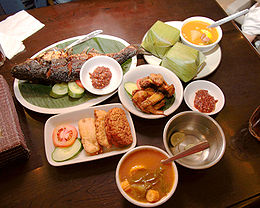
Indonesian cuisine is a collection of various regional culinary traditions that formed in the archipelagic nation of Indonesia. There are a wide variety of recipes and cuisines in part because Indonesia is composed of approximately 6,000 populated islands of the total 17,508 in the world's largest archipelago, with more than 1,300 ethnic groups.
There are many regional cuisines, often based upon indigenous culture with some foreign influences. (Full article...)
Selected ingredient –
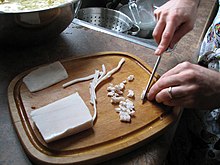
A lardon, also spelled lardoon, is a small strip or cube of fatty bacon, or pork fat (usually subcutaneous fat), used in a wide variety of cuisines to flavor savory food and salads. In French cuisine, lardons are also used for larding, by threading them with a needle into meats that are to be braised or roasted. Lardons are not normally smoked, and they are made from pork that has been cured with salt.
In French cuisine, lardons are served hot in salads and salad dressings, as well as on some tartes flambées, stews such as beef bourguignon, quiches such as Quiche Lorraine, in omelettes, with potatoes, and for other dishes such as coq au vin. (Full article...)
Selected recipe –
Vindaloo or Vindalho is an Indian curry dish, originally from Vasai and Goa.
It is based on the Portuguese dish carne de vinha d'alhos. It is known globally in its British Indian form as a staple of curry house and Indian restaurant menus and is often regarded as a fiery, spicy dish. The traditional recipe uses pork, but alternative versions have been prepared with beef, mutton, prawns, chicken, lamb, vegetables and tofu. (Full article...)
Alexis Benoît Soyer (French pronunciation: [alɛksi swaje] 4 February 1810 – 5 August 1858) was a French chef, philanthropist, writer and inventor who made his reputation in Victorian England.
Born in north-east France, Soyer trained as a chef in Paris, and quickly built a career that was brought to a halt by the July Revolution of 1830. Moving to England he worked in the kitchens of royalty, the aristocracy and the landed gentry until 1837. He was then appointed head chef of the Reform Club in London, where he designed the kitchens on radical modern lines and became celebrated for the range and excellence of his cooking. His best-known dish, lamb cutlets Reform, has remained on the club's menu since the 1840s and has been taken up by later chefs from Auguste Escoffier to Prue Leith. (Full article...)
Selected image –
Selected biography –
B. 10 August 1814 – d. 7 July 1890
Henri Nestlé (French pronunciation: [ɑ̃ʁi nɛsle]; born Heinrich Nestle, German: [ˈhaɪnrɪç ˈnɛstlə]; 10 August 1814 – 7 July 1890) was a German-Swiss confectioner and the founder of Nestlé, the world's largest food and beverage company. (Full article...)
Did you know (auto-generated) –

- ... that food stylist Susan Spungen estimated that she baked hundreds of pies with Josh Brolin and film staff while practicing for a scene in Labor Day?
- ... that strawberry pie is one of the "red foods" traditionally served at Juneteenth celebrations?
- ... that Turkish migrant workers living in a residential complex in Amsterdam refused to eat the Dutch food for two weeks after the kitchen's only Turkish chef was fired?
- ... that New Zealand editor and journalist Madeleine Chapman, known for fashion label exposés and snack food ranking lists, is a champion javelin thrower?
- ... that Gleaners Food Bank has served more than 700 million pounds (320 million kg) of food in Indiana?
- ... that Cranksgiving has been described as "part bike ride, part food drive, part scavenger hunt"?
More did you know –
Related portals
Food topics
The following are topics relating to food
Categories
Food list articles
- See also: Lists of foods and Category:Lists of drinks
The following are some Food list articles on Wikipedia:

- American cheeses
- Appellation d'Origine Contrôlée cheeses
- Apple cultivars
- Bacon dishes
- Bacon substitutes
- Basil cultivars
- Breads
- Breakfast beverages
- Breakfast cereals
- Breakfast foods
- British cheeses
- Cakes
- Candies
- Cheeses
- Cheese soups
- Christmas dishes (list)
- Cocktails
- Cookies
- Dishes using coconut milk
- Diets
- Doughnut varieties
- Egg dishes
- Fermented soy products
- Food additives
- Food additives (Codex Alimentarius)
- Foods named after people
- French cheeses
- French dishes
- Fried dough foods
- Fruits
- List of hamburgers
- Herbs and spices
- Hors d'oeuvre
- Indian dishes
- Indian snack foods
- Indonesian dishes
- Italian dishes
- Japanese snacks
- Japanese dishes
- Jewish dishes
- Kebabs
- Korean beverages
- Mango cultivars
- Moroccan dishes
- Pasta
- Pastries
- Philippine snack food
- Pies, tarts and flans
- Poppy seed pastries and dishes
- Potato dishes
- Puddings
- Raw fish dishes
- Rice dishes
- Rolled foods
- Sauces
- Seafood
- Seeds
- Sandwiches
- Snack foods
- Soft drinks by country
- Soul foods and dishes
- Soups
- Stews
- Street foods
- Tapas
- Turkish dishes
- Twice-baked foods
- Vegetable oils
- Vegetables
- Vodkas
Things you can do
Related WikiProjects
| Parent project: WikiProject Food and Drink | |
| Child projects: | Task forces: (All inactive) |
|
|
| Related projects: | |
New articles
Rules | Match log | Results page (for watching) | Last updated: 2024-11-23 19:20 (UTC)
Note: The list display can now be customized by each user. See List display personalization for details.
- Give Me a Band and a Bandana (edit | talk | history | links | watch | logs | tools) by Rn.brito (talk · contribs · new pages (4)) started on 2024-11-23, score: 10
- Vaillant's smooth-head (edit | talk | history | links | watch | logs | tools) by Quetzal1964 (talk · contribs · new pages (109)) started on 2024-11-23, score: 10
- Ya dong (edit | talk | history | links | watch | logs | tools) by Paul 012 (talk · contribs · new pages (10)) started on 2024-11-23, score: 10
- Suan la fen (edit | talk | history | links | watch | logs | tools) by 8UB3RG1N3 (talk · contribs · new pages (3)) started on 2024-11-23, score: 10
- Kuanfen noodles (edit | talk | history | links | watch | logs | tools) by 8UB3RG1N3 (talk · contribs · new pages (3)) started on 2024-11-22, score: 10
- 8424 watermelon (edit | talk | history | links | watch | logs | tools) by CanonNi (talk · contribs · new pages (15)) started on 2024-11-22, score: 10
- Chloronitramide anion (edit | talk | history | links | watch | logs | tools) by Mrfoogles (talk · contribs · new pages (9)) started on 2024-11-21, score: 10
- Candia (brand) (edit | talk | history | links | watch | logs | tools) by Leeanah (talk · contribs · new pages (15)) started on 2024-11-21, score: 10
- The Return of Don Quixote (edit | talk | history | links | watch | logs | tools) by Justinkrivers (talk · contribs · new pages (3)) started on 2024-11-21, score: 10
- Portland Cider Company (edit | talk | history | links | watch | logs | tools) by Another Believer (talk · contribs · new pages (96)) started on 2024-11-20, score: 10
- Four Faultless Felons (edit | talk | history | links | watch | logs | tools) by Justinkrivers (talk · contribs · new pages (3)) started on 2024-11-17, score: 10
- 290 (disambiguation) (edit | talk | history | links | watch | logs | tools) by 88.235.214.122 (talk · contribs · new pages (13)) started on 2024-11-12, score: 20
- 287 (disambiguation) (edit | talk | history | links | watch | logs | tools) by 88.235.214.122 (talk · contribs · new pages (13)) started on 2024-11-12, score: 20
- D82 (edit | talk | history | links | watch | logs | tools) by 88.235.214.122 (talk · contribs · new pages (13)) started on 2024-11-12, score: 20
- 901 (disambiguation) (edit | talk | history | links | watch | logs | tools) by 88.235.214.122 (talk · contribs · new pages (13)) started on 2024-11-12, score: 20
- Ian Macleod Distillers (edit | talk | history | links | watch | logs | tools) by Angryskies (talk · contribs · new pages (2)) started on 2024-11-20, score: 10
- Tibet Development Company (edit | talk | history | links | watch | logs | tools) by TinaLees-Jones (talk · contribs · new pages (84)) started on 2024-11-20, score: 20
- Jam Jams (edit | talk | history | links | watch | logs | tools) by 74.3.135.94 (talk · contribs · new pages (3)) started on 2024-11-18, score: 20
- David R. Chan (edit | talk | history | links | watch | logs | tools) by Mikeblas (talk · contribs · new pages (4)) started on 2024-11-18, score: 10
- Murad Al-Katib (edit | talk | history | links | watch | logs | tools) by Mary Mark Ockerbloom (talk · contribs · new pages (8)) started on 2024-11-16, score: 10
- Sofi Malt SE (edit | talk | history | links | watch | logs | tools) by AsteriodX (talk · contribs · new pages (21)) started on 2024-11-17, score: 10
- Clinking glasses (edit | talk | history | links | watch | logs | tools) by Викидим (talk · contribs · new pages (11)) started on 2024-11-16, score: 10
- Look at This Blue (edit | talk | history | links | watch | logs | tools) by Phibeatrice (talk · contribs · new pages (192)) started on 2024-11-15, score: 10
- Kosher slaughterer (edit | talk | history | links | watch | logs | tools) by Boxes12 (talk · contribs · new pages (10)) started on 2024-11-15, score: 10
- Pflaumentoffel (edit | talk | history | links | watch | logs | tools) by Thriley (talk · contribs · new pages (120)) started on 2024-11-15, score: 10
- CTV Specialty Television (edit | talk | history | links | watch | logs | tools) by 76.67.94.153 (talk · contribs · new pages (1)) started on 2024-11-15, score: 10
- Dry fruits (edit | talk | history | links | watch | logs | tools) by WikieMouse (talk · contribs · new pages (2)) started on 2024-11-15, score: 20
- Mahura flower (edit | talk | history | links | watch | logs | tools) by Ameliahill08 (talk · contribs · new pages (2)) started on 2024-11-14, score: 10
- Nuts.com (edit | talk | history | links | watch | logs | tools) by Thriley (talk · contribs · new pages (120)) started on 2024-11-14, score: 20
- Alexei Zimin (edit | talk | history | links | watch | logs | tools) by No Swan So Fine (talk · contribs · new pages (7)) started on 2024-11-14, score: 10
- Ghost (company) (edit | talk | history | links | watch | logs | tools) by Thriley (talk · contribs · new pages (120)) started on 2024-11-13, score: 10
- Dhayalan Mohanasundaram (edit | talk | history | links | watch | logs | tools) by Ashwinijaya09 (talk · contribs · new pages (1)) started on 2024-11-13, score: 20
- 2025 NHRA Mission Foods Drag Racing Series (edit | talk | history | links | watch | logs | tools) by Racecarz (talk · contribs · new pages (1)) started on 2024-11-12, score: 10
- Fleshy fruit (edit | talk | history | links | watch | logs | tools) by WikieMouse (talk · contribs · new pages (2)) started on 2024-11-12, score: 10
- Kaak (bread) (edit | talk | history | links | watch | logs | tools) by Paraw (talk · contribs · new pages (1)) started on 2024-11-12, score: 30
- Mao tofu (edit | talk | history | links | watch | logs | tools) by Cs california (talk · contribs · new pages (4)) started on 2024-11-12, score: 10
- CorkScrew BBQ (edit | talk | history | links | watch | logs | tools) by Another Believer (talk · contribs · new pages (96)) started on 2024-11-12, score: 10
- LeRoy and Lewis Barbecue (edit | talk | history | links | watch | logs | tools) by Another Believer (talk · contribs · new pages (96)) started on 2024-11-12, score: 10
- La Barbecue (edit | talk | history | links | watch | logs | tools) by Another Believer (talk · contribs · new pages (96)) started on 2024-11-12, score: 10
- InterStellar BBQ (edit | talk | history | links | watch | logs | tools) by Another Believer (talk · contribs · new pages (96)) started on 2024-11-12, score: 10
- Trivet (edit | talk | history | links | watch | logs | tools) by Espoo (talk · contribs · new pages (1)) started on 2024-11-11, score: 10
- MINIMAL (restaurant) (edit | talk | history | links | watch | logs | tools) by Horse Eye's Back (talk · contribs · new pages (10)) started on 2024-11-11, score: 10
- Lyon cup (edit | talk | history | links | watch | logs | tools) by Tenpop421 (talk · contribs · new pages (17)) started on 2024-11-10, score: 10
- Gan Guê To (edit | talk | history | links | watch | logs | tools) by Thyj (talk · contribs · new pages (3)) started on 2024-11-10, score: 20
- Jackie Reid (edit | talk | history | links | watch | logs | tools) by Tassedethe (talk · contribs · new pages (300)) started on 2024-11-09, score: 10
Associated Wikimedia
The following Wikimedia Foundation sister projects provide more on this subject:
-
Commons
Free media repository -
Wikibooks
Free textbooks and manuals -
Wikidata
Free knowledge base -
Wikinews
Free-content news -
Wikiquote
Collection of quotations -
Wikisource
Free-content library -
Wikiversity
Free learning tools -
Wiktionary
Dictionary and thesaurus















